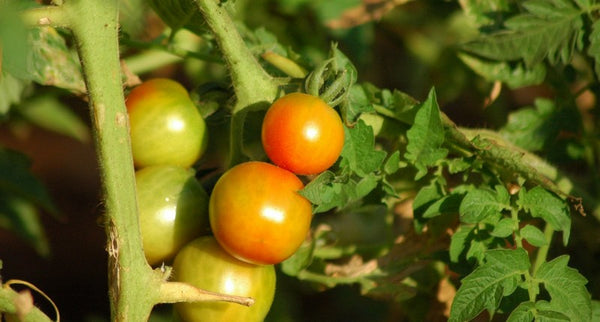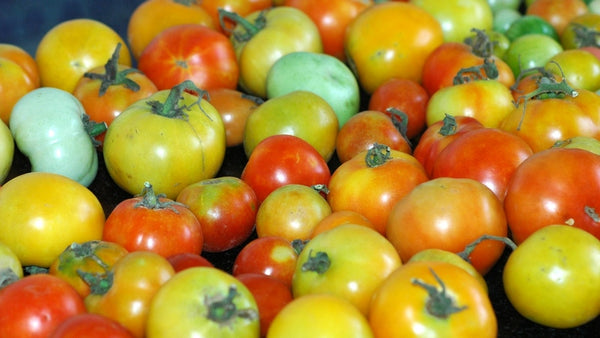Tomatoes (belonging to the very productive Solanaceae family) are probably the most popular crop grown in kitchen gardens across the world, and India is no exception. Extremely popular in Indian cuisine (probably 3rd, only behind potatoes and onions among vegetables), it is one of the rare foods that is enjoyed almost as much raw as it is cooked.
However, tomatoes are often not the easiest to grow (especially in wet tropical climates) and the plant is affected by a wide array of pests – which can differ from place to place.
Note: Many of the more important tips here were shared by Meenakshi Arun, Uma Shashikant, Amol Kulkarni, Nitya Ramakrishnan from the OTG – Facebook group (and are quoted verbatim).
What kind of soil is best suited for growing tomatoes?
Well drained loamy soils rich in organic matter are ideal. The drainage is probably the most important aspect of the soil characteristics since mane of the challenges with growing tomatoes can be attributed to soil-borne micro-organisms and soil deficiencies.
If you are growing in pots, then a mix of 50% garden soil (for a good stable base), 25% sand and 25% vermicompost is probably the best choice.
How simple is it to grow tomatoes?
In the right conditions, this is one of the easiest vegetables to grow by far – but in the wrong conditions (hot and wet) they can be challenging. The seeds germinate very easily in India (in fact they are almost weed like) and it often shows up in your compost heap or pile or even self-seed if you leave the tomato on there to ripen.
Tomatoes are, by far, the most popular vegetables amongst gardeners across the world.
What type of climate is good for tomatoes?
Bangalore weather is ideal for tomatoes almost all year round.. you should not be surprised also to see a stay tomato plant almost anywhere you go. Sometimes the roadside/gutter/compost heap plants yield heavily with minimal care – compared to the ones we mollycoddle in our gardens. Its more difficult for places where temperatures go much beyond 32°c in the spring/summers.
Water regularly but not so much that it is standing in water for long. It comes down to soil and sun. They do need fertilizing as they flower and set fruit. So that’s when you want to definitely give them whatever food you give other plants.
What kind of nutrition should I provide my tomato plants?
This crop needs a lot of nutrition, so well composted soil should be a starting point. Put in some chuna (to prevent blossom end rot) and some wood ash (for better flower retention) as additional “manuring” practices. Panchagavya diluted as a foliar spray is also an excellent idea for greater productivity.
An additional manuring before each flowering round (in indeterminate) is a good idea too. Pruning back an indeterminate plant seems to help the second round of production (experts please confirm).
All intermediate branches should be pinched off (between the stem and the main branch) so as to concentrate the food on fewer branches which will mature and produce fruit.
Which are the common pest problems or diseases associated with tomatoes
Things that worry us most are Fusarium wilt (fungal), Bacterial Wilt and Root knot nematodes (soil-borne). Others that people often complain about are leaf miner, blossom-end rot (BER), Fruit borer and Leaf curl.
While is may seem like there are many problems than can afflict tomatoes , these are fortunately not all of the type to occur in the same place. Bangalore seems ideal – cool weather, not much rain and pretty nippy in the winter which seems to work better for the beef-stake varieties. The maximum challenges are likely to occur in either very hot or very moist environments (coastal places like Goa, Mumbai, Mangalore, Chennai).

Cherry tomato varieties are usually hardier and easier to grow
A little leaf miner is nothing to get very upset about, just make sure that its less than 25% of the leaves on the plant or it begins affecting production. Best companions seem to be ones with stronger smelling leaves (primarily pest resistance), Basil, Marigolds, Garlic and Sweetcorn seem to make a lot of sense.
Why do my tomatoes suddenly wilt and die?
Wilt is one of the most important issues with the tomato plant and seems to strike them down almost without warning. There are fungal and bacterial wilt issues, and its not easy to make out the difference. If you have a plant wilt and die suddenly – uproot it and look for nodules/bumps on the roots. This makes it a good idea to practice crop rotations especially in pots which have had tomatoes growing for a season.
This is most likely to be due to one of the following – Fusarium wilt (fungal), Bacterial Wilt and Root knot nematodes (soil-borne). Treating your compost with Trichoderma Virde (a fungus) can help considerably to eliminate fungal wilt from the soil by preventing other “bad” fungii in places where it has established. Nematodes are traditionally dealt with by companion planting of marigold which has root secretions which eliminate the nematodes from the soil.
When transplanting tomatoes – keep the following in mind.
Transplanting is really important for tomatoes – they really seem to grow and produce better when transplanted. Remember to soak the seedlings in trichoderma virde solution (1tbsp in 1 lit water), or add some compost pre-innoculated with trichoderma virde (sprinkling a small amount of this powder on your moist compost pile and leaving it the shade for three days). This will protect your plant against fungal diseases (like fusarium wilt).
Another tip for when you are transplanting your tomatoes – strip out the bottom few leaves and put the seedling really deep in the ground. All those little hairs visible on the seedling stems are wannabe roots, and will form a strong root system when they come in contact with the soil. This will ultimately yield a healthier and more productive plant.
How does one know if a plant is determinate or indeterminate?
While the best time to check on this is when you are opening your seed packets (usually mentioned there), you will figure it out presently anyway – the determinate is a bush, while the indeterminate will be a longer creeper.
Expect determinate types to stop growing taller than 3 ft and become bushy. Indeterminate toms will be tall vines. Determinate will yield all in one go and die, indeterminate go on producing flowers and fruits. Most hybrids are determinate. Determinate OP Tomatoes exist and could best suit small spaces as they are compact. Staking is necessary for the indeterminate (long creeper) variety and a good idea for the determinate too (bushy types).
The flower clusters will appear after 3+ leaf nodes in indeterminate variety. Where as for determinate they appear more frequently.
Which varieties of tomatoes should we be looking to grow?
As far as varieties of tomatoes are concerned, I think that the cherry tomatoes are easiest to grow, regular sizes are next and the beefstake variety seem a little more difficult (in Goa). Bangalore and Pune should be happy with all of them – Delhi and Hyderabad may be challenging in the heat.
The varieties that we have liked best so far are – Desi tomatoes (Navadanya), Rutgers, Caro rich, Podland pink, Golden delight and Galina from Annadana. But our experiences with them have not been extensive. The dark/black/purple varieties have been a failure for us so far.
What should you keep in mind if you are growing in a coastal city of India?
If you are in Mumbai, Mangalore, Chennai and Goa – there is work to be done if you want results.
- Make sure that you have a semi-shady area with about 4 hours of sun (preferably morning sun)
- Make your raised beds really high (maybe as much as 10-12″ especially if you want to try in the monsoon
- You will need to create a shelter (plastic?) so they dont get drenched in the monsoon.
- If you are growing in pots, the idea of solarising soil seems a good one (solve the fungal and nematode issues that worry us most)
- Leaf miner will happen and wood ash and diluted cow urine sprays seem enough of a deterrent.
- Treating your compost with trichoderma virde is critical as fungal wilt is very common in the coastal stretch and companion planting of marigold is similarly important.
How to save tomato seeds, (and why)?
Regarding saving tomato seeds – the seeds need to be fermented to remove the protective, ‘mucusy’ covering. Dump the seeds in a container full of water. Then cover and store for about a week, stirring daily. Then filter out the seeds and dry them for storage.
Can I improve tomato performance in really hot weather?
You can try and incorporate a 50% shade net to try and bring that temperature down at the midday. You can also grow a trellis of gourds or beans and plant the tomatoes below them so that have some shade for them and prevent them from wilting excessively...

